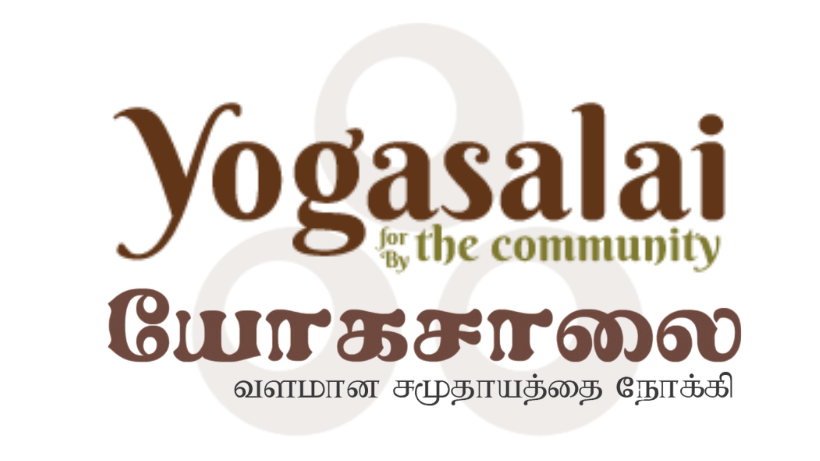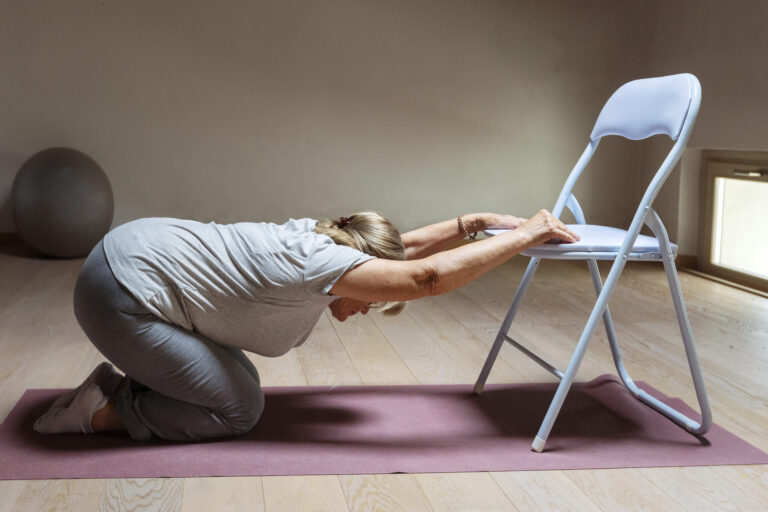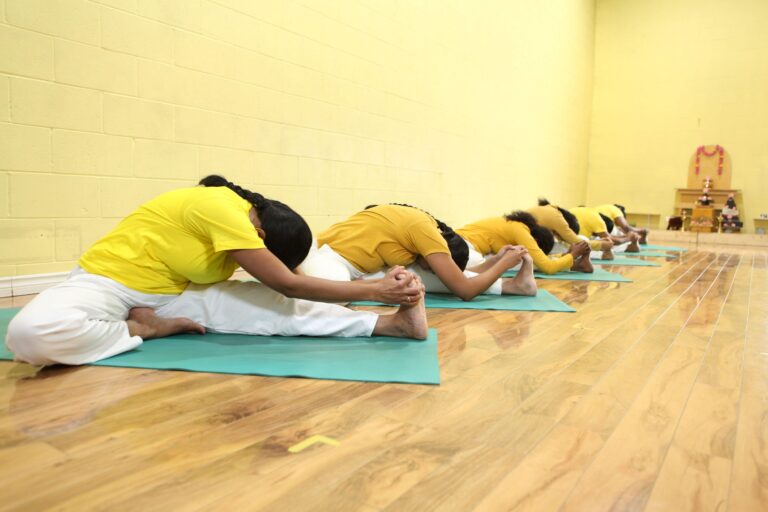
ஆசனம் (Āsana)

இக்காலச் சூழலில் யோகப் பயிற்சிகளுள் பலராலும் அதிகமாகப் பயிற்சி செய்யப்படுவது ஆசனப் பயிற்சிகள் எனலாம்.
ஆசனம் என்பதன் பொருள் நிலையாக இருப்பது என்பதாகும்.
உடல், மனம் மற்றும் உயிர் சக்தியை நிலைப்படுத்தும் நோக்கத்துடன் செய்யப்படும் பயிற்சியே ஆசனப்பயிற்சி ஆகும்.
உடல் நலன் பேணுதல், மனதை ஒருநிலைப்படுத்தல், மனோநிலையைப் பெறுதல், மூச்சைச் சீர்படுத்தல், உயிர் ஆற்றலின் சீரான ஓட்டத்தைப் பேணுதல் — இவை அனைத்தும் ஆசனப் பயிற்சியின் பயன்களாகும்.
உடல் நலத்தைப் பேணுதல் என்பது உள்ளுறுப்புக்களின் சீரான செயல்பாட்டைக் குறிக்கும்.
ஆசனப்பயிற்சி இதற்கு மிகுந்த உறுதுணையாகும்.
ஆசனப்பயிற்சியின் தனித்துவம்
எந்த ஒரு உடற்பயிற்சியுடனும் ஒப்பிட முடியாத தனித்துவமான பயிற்சியே ஆசனம் ஆகும்.
உடலின் கட்டமைப்பு, அதன் செயல்பாடு, மனதின் தன்மை மற்றும் உயிர்ச்சக்தியின் ஓட்டத்தை திருத்தும் வல்லமை ஆசனங்களுக்கு உண்டு.
ஆசனப்பயிற்சி ஒரு சிறந்த உடற்பயிற்சியாக மட்டுமல்ல, மூச்சுப்பயிற்சி (பிராணாயாமம்) மற்றும் தியானப் பயிற்சிக்குத் தயார்படுத்தும் சிறந்த வழியாகவும் விளங்குகிறது.
உடலை நிலைப்படுத்தி, புலன்களை அடக்கி, மனதை ஒருநிலைப்படுத்தி, எம்மை தியானத்திற்குத் தயார்படுத்துகின்றது.
ஆசனப்பயிற்சியின் முக்கியத்துவம்
- பிராணவாயுவின் அளவைச் சரியாக வைத்திருக்கும்.
- ஆசனங்கள் நிதானமான அசைவுகளுடன், ஆழ்ந்த சுவாச முறையுடன் இணைத்து செய்யப்பட வேண்டும்.
- தளர்த்தும் பயிற்சிகளுடன் இணைத்து மேற்கொண்டால் உடல் மற்றும் மனம் சமநிலை பெறும்.
அகநிலை பயிற்சி மூலம் ஏற்படும் ஒழுங்கு, ஆசனத்தின் உறுதிநிலையை அடைய வழிவகுக்கும்.
இதுவே நீண்ட நேரம் ஒரு நிலையில் தொடர்ந்திருக்க உதவும்.
ஆசனத்தின் நோக்கம்
பலவிதமான இருக்கை நிலைகளில் உடம்பை வளைப்பதன் மூலம்
- உடல் நலத்தையும்
- மன வலிமையையும் பெறுவதே ஆசனத்தின் நோக்கம்.
கட யோகம், அட்டாங்க யோகம், கிரியா யோகம் போன்ற யோக முறைகளில் ஆசனப் பயிற்சி முக்கிய இடம் பெறுகிறது.
திருமூலர் கூறும் ஆசனங்கள்
பத்திரம் கோமுகம் பங்கயம் கேசரி
சொத்திரம் வீரஞ் சுகாதானம் ஓரேழும்
உத்தம மாமுது ஆசனம் எட் டெட்டு
பத்தோடு நூறு பல ஆசனமே
திருமூலர் குறிப்பிடுவது போல, பத்திரம், கோமுகம், பங்கயம், கேசரி, சொத்திரம், வீரம், சுகாசனம் ஆகிய ஏழு ஆசனங்கள் யோகத்தின் உச்ச நிலைகளாகும்.
அத்துடன் நூற்றுக்கும் மேற்பட்ட ஆசனங்கள் இருப்பதாகவும் அவர் கூறுகிறார்.
பிராணாயாமமும் ஆசனமும்
ஆசனப் பயிற்சியின் மூலம் உயிர்சக்தி (பிராணன்) கட்டுப்பாட்டில் வைக்கப்படுகிறது.
மூச்சை சரியாகப் பயன்படுத்தி ஆசனத்தைச் செய்வது, பிராணாயாமத்திற்கு முன்னோட்டமாக அமைகிறது.
பிரத்யாகாரமும் ஆசனமும்
புலன்களை அடக்குதல் பிரத்யாகாரம் ஆகும்.
புலன் அடக்கம் இல்லாமல் எந்தச் செயலும் முழுமையாகச் செய்ய இயலாது.
ஆசனப் பயிற்சி புலனடக்கத்தை வளர்க்கும் சிறந்த வழியாகும்.
தாரணை, தியானம் மற்றும் ஆசனம்
மனம் ஒருநிலைப்படுத்தப்படுவதால் தாரணை கைகூடும்.
தியானப் பயிற்சிக்கு ஏற்ற ஆசனங்கள்:
- பத்மாசனம் (தாமரைப் பூப்போல்)
- சித்தாசனம்
- சுவத்திகாசனம்
- சுகாசனம்
தியானத்திற்கான சரியான ஆசனம் மற்றும் தொடர்ச்சியான பயிற்சியே வெற்றியை அளிக்கும்.
சமாதியும் ஆசனமும்
மனத்தின் முழு அமைதியே சமாதி நிலை.
ஆசனத்தின் வழியாக உடல் மற்றும் மனத்தை கடந்து, உயிரின் ஆழ்நிலையை அடையலாம்.
ஆசனத்தின் அறிவியல் அடிப்படை
ஆசனம் என்பது உடலை ஒரு நிலையில் வைத்தபடி சக்தியைச் செயல்படுத்தும் நிலை.
இது புவியீர்ப்பு, மூச்சு, வெப்பம், அழுத்தம் போன்ற இயற்கை சக்திகளின் ஒத்துழைப்பில் நடைபெறும்.
ஆசனப்பயிற்சியின் நன்மைகள்
- நீண்ட ஆயுளை ஊக்குவிக்கும்.
- தசை சமநிலையைப் பேணுகிறது.
- முதுகுத் தண்டை வலுப்படுத்துகிறது.
- இரத்த ஓட்டத்தை மேம்படுத்துகிறது.
- உடலின் உள் உறுப்புகள், சுரப்பிகள் மற்றும் நரம்பு மண்டலத்தின் செயல்பாட்டை சீர்படுத்துகிறது.
- உடலுக்கு வலிமை, உறுதி, இலகுத்தன்மை அளிக்கிறது.
மூச்சின் தன்மை
ஆசனத்தில் செல்லும் போதும், வெளியேறும் போதும் மூச்சை கவனிக்க வேண்டும்.
- முன்னால் வளையும் போது: மூச்சை வெளியே விடவும்.
- ஆசனத்திலிருந்து எழும்பும் போது: மூச்சை உள்ளே இழுக்கவும்.
- ஆசனத்தில் நிலை கொள்ளும் போது: இயல்பான அல்லது நீண்ட மூச்சு.
மூச்சை பிடித்துக்கொள்வது அல்லது உடம்பை இறுக்குவது தவிர்க்கப்பட வேண்டும்.
பயிற்சியின் நேர அளவு
ஒவ்வொரு ஆசனத்திற்கும் குறிப்பிட்ட நேர அளவில் மட்டும் நிலை கொள்ள வேண்டும்.
அதிக அழுத்தம், தசை பிடிப்பு அல்லது சோர்வு ஏற்படாமல் இருக்க இதை கடைபிடிக்க வேண்டும்.
மாற்று ஆசனங்கள் (எதிர் ஆசனங்கள்)
ஒவ்வொரு ஆசனத்திற்கும் எதிர் ஆசனங்கள் உள்ளன.
இவை சக்தி ஓட்டத்தையும் தசை அழுத்தத்தையும் சமநிலைப்படுத்துகின்றன.
எடுத்துக்காட்டுகள்:
- பச்சிமோத்தாசனம் ↔ சாய்மனை ஆசனம்
- பாம்பு, வெட்டுக்கிளி, வில் ஆசனம் ↔ சிசு ஆசனம்
- தோளில் நிற்கும் ஆசனம் ↔ மீனாசனம்
ஆசன வகைகள்
- முன்னால் வளையும் ஆசனங்கள்
- பின்னால் வளையும் ஆசனங்கள்
- முதுகை முறுக்கும் ஆசனங்கள்
- நின்று செய்யும் ஆசனங்கள்
- படுத்து செய்யும் ஆசனங்கள்
- தலைகீழ் ஆசனங்கள்
எடுத்துக்காட்டுகள்
பச்சிமோத்தாசனம்
- மூச்சு: முன்னால் வளையும் போது மூச்சை வெளியே விடவும்.
- நேரம்: 30–45 வினாடிகள் (புதியவர்கள்), படிப்படியாக 5 நிமிடங்கள் வரை.
- மாற்று ஆசனம்: சாய்மனை ஆசனம்.
பாம்பாசனம்
- மூச்சு: உள்ளே இழுத்து தலை, நெஞ்சு மேலே.
- நேரம்: 30 வினாடி–1 நிமிடம்.
வெட்டுக்கிளி ஆசனம்
- மூச்சு: உள்ளே இழுத்து கால்களை மேலே தூக்கவும்.
- நேரம்: 5–30 வினாடிகள்.
வில் ஆசனம்
- மூச்சு: உள்ளே இழுத்து தலை, நெஞ்சு, தொடைகள் மேலே.
- நேரம்: 30 வினாடி–1 நிமிடம்.
- மாற்று ஆசனம்: சிசு ஆசனம்.
சிசு ஆசனம்
- மூச்சு: செல்லும் போது மூச்சை வெளி விடவும்.
- நேரம்: 30 வினாடி–1 நிமிடம்.
- ஓய்வு ஆசனம்: 5–6 நீண்ட மூச்சு.
நின்று முன்னால் வளையும் ஆசனம்
- மூச்சு: முன்னால் வளையும் போது வெளி விடவும்.
- நேரம்: 30 வினாடி–1 நிமிடம்.
- 3–6 முறை செய்யலாம்.
தோளில் நிற்கும் ஆசனம்
- முழு உடலுக்கும் பயிற்சி.
- நேரம்: 30 வினாடி–3 நிமிடம் வரை.
- மாற்று ஆசனம்: மீனாசனம்.
சவாசனம்
பயிற்சியின் தொடக்கத்திலும் முடிவிலும் செய்ய வேண்டிய முக்கிய ஆசனம்.
உடல், மனம், உயிர் அனைத்தும் முழுமையான ஓய்வை அடையும் நிலை.
இதில் தான் ஆசனப்பயிற்சியின் பலன்கள் முழுமையாகக் கைகூடும்.
முடிவுரை
ஆசனப் பயிற்சியால் ஏற்படும் நன்மைகள் அளவற்றவை.
ஆயிரக்கணக்கான ஆண்டுகளாக கோடிக்கணக்கான மக்களால் பயிற்சி செய்யப்பட்டு வரும் இப்பயிற்சிகள் எமக்கும் நன்மை தருவன.
முறையான ஆசானின் வழிகாட்டுதலுடன், ஒழுங்கான தினசரி பயிற்சியாக மேற்கொண்டால் —
ஆசனம் உடலுக்கும், மனதுக்கும், உயிருக்கும் சமநிலையை அளிக்கும் மிக உயர்ந்த யோக வழி ஆகும்.
Āsana
In today’s world, among the various yoga practices, āsana practice is the most widely followed.
The word āsana literally means to remain steady or stable.
Āsana practice is a discipline performed with the intention of stabilizing the body, mind, and vital energy (prāṇa).
The purposes of āsana practice include maintaining physical health, calming and focusing the mind, achieving mental equilibrium, regulating the breath, and ensuring the smooth flow of vital energy.
Maintaining physical health refers to the proper functioning of the internal organs — something that āsana practice strongly supports.
Compared to any other physical exercise, āsana is unique.
It has the power to influence and refine the structure and function of the body, the tendencies and activities of the mind, and the movements of the life force (prāṇa).
Āsana as Preparation
Āsana practice not only serves as a profound form of physical exercise but also prepares us for prāṇāyāma (breath regulation) and dhyāna (meditation).
It strengthens the muscles, nerves, internal organs, and the energy channels of the body.
It steadies the body, disciplines the senses, and focuses the mind — making us ready for meditation, which is known to bring immense mental peace and clarity.
Thus, āsana serves as the foundation for many higher yoga practices.
The Method of Āsana Practice
The āsana system emphasizes performing each posture slowly and steadily, in rhythm with deep breathing and relaxation.
Through inner awareness (self-discipline and mindfulness), stability is developed, allowing one to remain in a posture for an extended period.
The purpose of āsana is to achieve both physical health and mental strength by stretching and steadying the body in various positions.
Most traditional āsanas are found in Haṭha Yoga, though practitioners of arts such as Silambam (Tamil martial art), Bharatanatyam (classical dance), and wrestling have also practiced āsanas as part of their preparation — a custom rooted in Tamil heritage.
While there are numerous āsanas, one can choose postures suited to their physical condition. Each posture offers specific benefits.
Tirumoolar’s Verse on Āsanas
“Padmasana, Gomukha, Bhadra, and Simha,
Svastika, Veera, and Sukha — these seven are supreme;
There are also a hundred and more varieties —
countless are the postures of yoga.”
— Tirumoolar, Thirumandiram
Tirumoolar identifies these seven as ancient and advanced āsanas, meant for experienced practitioners, but mentions that over 120 additional āsanas exist.
Āsana in Yoga Systems
Āsana is described as one of the eight limbs (Aṣṭāṅga Yoga), as well as an essential part of Kriya Yoga and Haṭha Yoga.
While āsana is only one of the eight limbs, it is among the most crucial, as it instills the discipline required for higher practices.
Ethical principles such as Yama and Niyama form the moral foundation of yoga and support one’s daily practice.
For instance, the discipline of practicing every day itself is a virtue that leads to success in āsana.
Āsana and Prāṇāyāma
Through āsana, the flow of prāṇa (vital energy) is controlled and directed.
The practice of āsana naturally incorporates breath awareness, making it an effective preparation for prāṇāyāma.
Āsana and Pratyāhāra
Pratyāhāra is the withdrawal of the senses.
Without mastering the senses, it is impossible to practice āsana effectively.
By gradually increasing the duration of each posture and maintaining steady focus, sensory control develops — making āsana a key step toward pratyāhāra.
Āsana and Dhāraṇā
With sensory control, the mind gains concentration (dhāraṇā).
Āsana practice itself both requires and develops mental steadiness — helping the practitioner to perform any task with complete focus.
Āsana and Dhyāna
Continuous one-pointed focus leads to meditation (dhyāna).
Certain āsanas are specifically suited for meditation, such as Padmāsana (Lotus posture), Siddhāsana, Svastikāsana, and Sukhasana.
Choosing the right posture and consistent practice are essential for success in meditation.
Generally, all āsanas enhance both physical health and mental stability, thereby supporting meditation practice.
Āsana and Samādhi
When the mind attains complete stillness and merges into a single wave of awareness, the state of Samādhi arises — transcending body and mind. Āsana ultimately prepares the practitioner for this supreme state.
Āsana and the Life Force
Āsana is not merely a physical position but a state of awareness in which the practitioner consciously regulates both body and energy.
While it may appear as a static physical pose to an observer, in reality, it is a dynamic state where energy activation and internal balance occur.
It harmonizes natural forces such as gravity, breath, and internal pressure to regulate bodily functions.
Other Benefits of Āsana
- Promotes longevity and overall health.
- Maintains muscular balance and flexibility.
- Strengthens the spine, which governs the nervous system.
- Improves blood circulation and supplies prāṇa to the nervous system.
- Provides relaxation, strength, resilience, and suppleness.
- Regulates the functions of organs, glands, tissues, and subtle systems.
Āsana and the Role of Breath
In every āsana, breath must be coordinated with movement:
- When bending forward — exhale.
- When bending backward — inhale.
- When coming out of a posture — inhale if you had exhaled entering it, and vice versa.
Breath should always be natural, deep, and never held or strained.
An āsana must be practiced steadily and comfortably — this is what distinguishes yoga from mere exercise.
Duration of Practice
Each āsana should be held only for the recommended duration to avoid strain or muscle tension.
Gradually increase the time to build balance and endurance of both body and mind.
Counterposes (Reverse Āsanas)
Every posture has a counterpose to neutralize its effects and balance the energy flow.
For example:
- Forward bend (Paścimottanāsana) → counterpose: Inclined plane/ Upward Plank Pose (Pūrvottānāsana).
- Backbends (Bhujangāsana, Śalabhāsana, Dhanurāsana) → counterpose: Child’s pose (Śiśāsana).
Practicing both sides equally (in poses like Trikonāsana) maintains symmetry.
Types of Āsanas
Āsanas can be classified as:
- Forward bends
- Backbends
- Twists
- Standing postures
- Supine (lying) postures
- Inverted postures
Examples of Āsanas
Forward Bend (Paścimottanāsana)
Sit with legs extended, bend forward, and hold the toes.
Breath: Exhale while bending, inhale while returning.
Duration: 30–45 seconds, gradually up to 5 minutes.
Counterpose: Bridge pose (Setubandhāsana).
Backbends
Cobra Pose (Bhujangāsana) – Lie prone, palms under shoulders, inhale and lift chest.
Locust Pose (Śalabhāsana) – Lie prone, lift both legs while inhaling.
Bow Pose (Dhanurāsana) – Hold ankles, inhale and lift chest and thighs.
Counterpose: Child’s Pose (Śiśāsana).
Standing Forward Bend
Stand tall, exhale, and fold forward to touch the feet.
Duration: 30 seconds to 1 minute.
Shoulder Stand (Sarvāṅgāsana)
Lie down, lift legs and hips upward, support back with hands.
Duration: 30 seconds to 3 minutes.
Counterpose: Fish Pose (Matsyāsana) – Arch the back, open chest, and breathe deeply.
Śavāsana (Relaxation Posture)
Performed at both the beginning and end of practice, Śavāsana allows for complete relaxation on physical, mental, and energetic levels.
It restores energy and integrates the benefits of all āsanas.
In this state, identification with body and mind ceases, allowing the life force to recharge deeply.
The benefits of āsana practice are countless. Practiced for thousands of years by millions, these postures continue to bring well-being and vitality to all who follow them. Though simple to learn, āsanas should ideally be practiced under the guidance of a qualified teacher.
Pathusha Ananthanadarajah


